Can your customers tell they're reading something created by your brand without seeing your name? Cultivating a strong brand voice has many benefits:
You become identifiable and memorable in the internet's sea of sameness.
You create better, consistent, and high-quality content for your audience.
Your in-house employees and contractors stay on the same page.
I've spent a lot of time reading and developing style guides, and this article will tell you everything you need to know about building a content style guide, from what it is, to whether your company truly needs it, to how to put one together.
What is a style guide?
A brand style guide contains a design style guide and a content style guide. The former is a visual identity laying out how your brand looks: the color palette you use for your logo, the typography, and brand assets.
But for this article, I'll focus on creating a content style guide: the editorial guidelines for tone, structure, voice, and values. You see it in the copywriting on your landing page, in your social media captions, and all over your content marketing.
If you think a documented style guide sounds not-so-essential, I don't blame you. Not every company needs a style guide, but I'd argue that most benefit immensely from it.
Do you need a style guide: Non-negotiable or time-suck?
Can you deliver quality content that matters and meets business goals without a style guide? It depends.
If you work at a very small company with a handful of employees (just a few team members in the marketing department), it's not worth spending your time creating a style guide just yet. You likely have other business priorities to look into first. With a small team size, it's easy to work without tons of documentation.
It also doesn't make sense to invest in a style guide when you're at an early stage in your company. You're probably still experimenting with your messaging, value proposition, and brand values. Things will change.
You can't justify dedicating resources to building a style guide if you're barely creating any content.
If you don't fall into that tight bracket, you'll be better off creating a content style guide. Consistency in brand representation when speaking to your customers is crucial, and a style guide solidifies your brand impression at scale.
But the content style guide needs of an enterprise company working with a large team and freelancers differ vastly from a tightly-knit company growing rapidly. The former needs thorough documentation and effective document templates. The latter needs a breathing document that's frequently updated. And then there are some elements both segments require.
How to create a style guide (with 14 style guide examples)
Over the years, I've seen a vast spectrum of style guides—from 30-page eBooks to barely half a page of the essentials. Neither extremes are ideal:
Too much information is overwhelming, and readers won't retain the important pointers.
Not enough information leaves too much room for ambiguity and differences to arise.
The sweet spot is somewhere in the middle—three to five pages of essentials and skimmable nitty-gritty details.
Here are ten elements to include in your company's style guide. Follow the essentials and cherry-pick what you need from the optional ones.
1. Company and product details like mission, values, and goals (essential)
The first thing someone should see in your style guide is details about your company: who you are, what you sell, your mission, and what your values are.
A brief about your company and products might seem non-essential if you don't work with external contractors, but it's crucial for onboarding new employees and getting in-house employees on the same page. Not to mention: Having your company's overview at the top of the style guide keeps your values and mission statement top-of-mind.
I love how Zendesk has highlighted the brand attributes in its style guide and briefly explained how they aim to meet those characteristics.
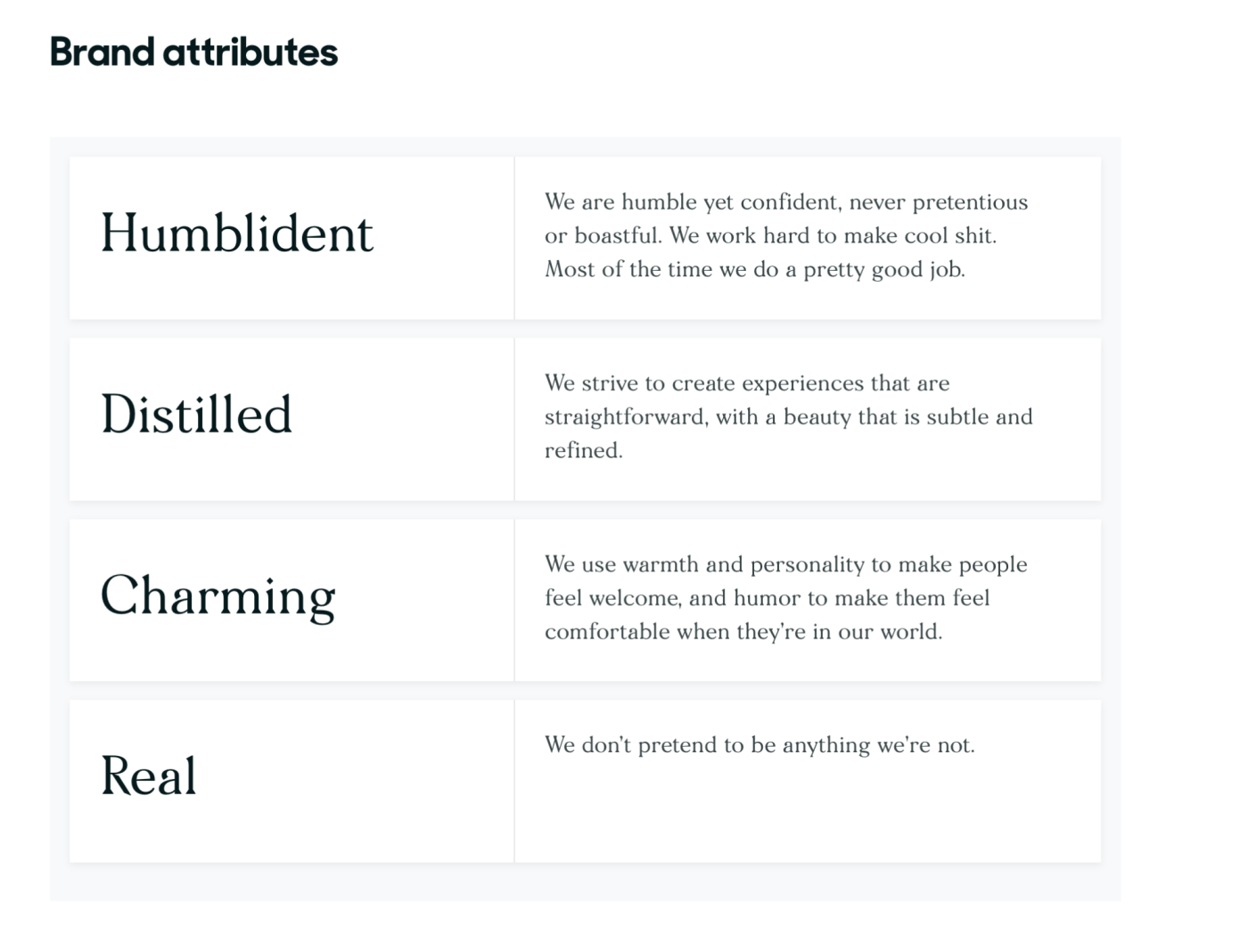
Company details are also the place where you can mention guidelines around how to use (and not use) your company's name. Slack's style guide has this in a short, sweet, and succinct way.
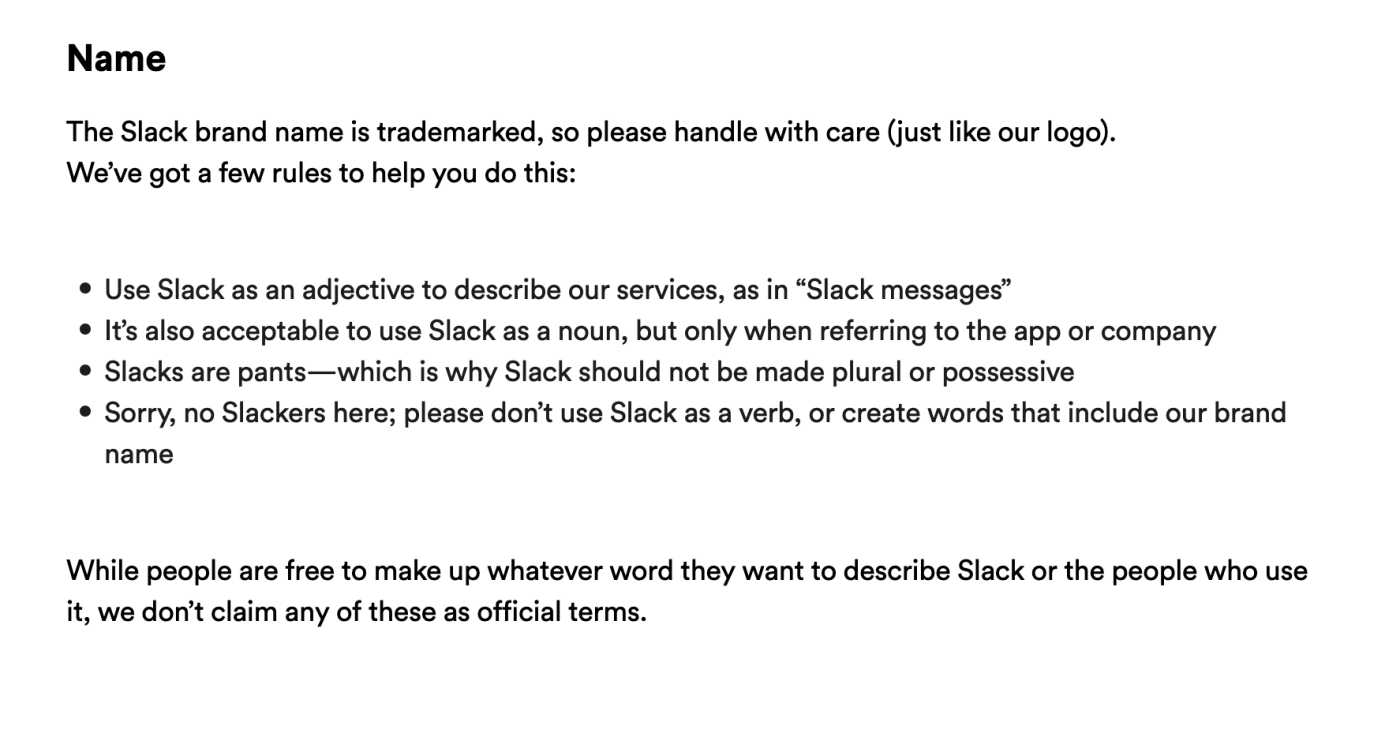
2. Voice and tone (essential)
I've encountered brands who are hip on their Instagram but stiff and professional on their website. It always leaves me feeling…confused. How can I trust a brand that sounds totally different on each channel? It's inauthentic.
Your social media, content, and copywriting teams need to sound consistent and be aligned with your brand's personality. So take a moment to craft what impression you want to leave on your readers and buyers. Are you helpful with a streak of silliness? Or are you professional and straightforward with no BS? Help Scout's style guide is an excellent example of getting it just right.

Zapier takes it up a notch by sharing its own persona as a company and what role they play in its audience's lives.

I definitely recommend writing something brief and similar to Zapier to understand who you are and how to speak to your customers in a few sentences.
But don't make this section too hoity-toity with no actionable way to embed your brand voice. Tommy Walker—founder of The Content Studio, former Global Editor-in-Chief at QuickBooks, first marketing hire at Shopify Plus, and host of The Cutting Room—says this is a common problem. The solution? He recommends sharing examples of "how we at company X say common things" to make it easy to understand how to interpret and use your brand voice:
"Style guides have a hard time holding up to multiple contexts. So it's up to the content lead to create their own interpretation of that [voice and tone] section so that it may be applied to writing itself."
3. Audience information like demographics, pain points, and how your product fits into their lives (essential)
Call it user personas or whatever you want: your employees and contractors need to understand who they're serving. Answer all basic questions like what's their job profile and what demographic they might be in.
But go beyond this and answer advanced questions too—like what are your customers' pain points, and what do they struggle with in their jobs? How else would your company's workers give customers what they want? For example, Eric Doty—content lead at Dock—shares who their target customers are and what they struggle with in his onboarding guide for freelancers.

He says this takes top priority (sometimes over grammar preferences)—especially when a contractor is writing for Dock for the first time:
"Writing an article with us for the first time feels more like being onboarded to our team, so it's more focused on educating the writers about our viewpoint and messaging rather than having them focus on tiny grammar nuances or things that can be fixed in editing."
Also include how your product fits into your ideal customer's life and what problems you solve for them. If you have the data, add details about where most of your customers come from and what friction they experience in purchasing your product or service. GitLab's style guide has thorough details on its potential buyers—their goals, who they report to, their biggest challenges, and so much more.

Intuit's style guide also has a section on communicating with customers in specific scenarios—like delivering bad news, writing emails, sending congratulations, and more.
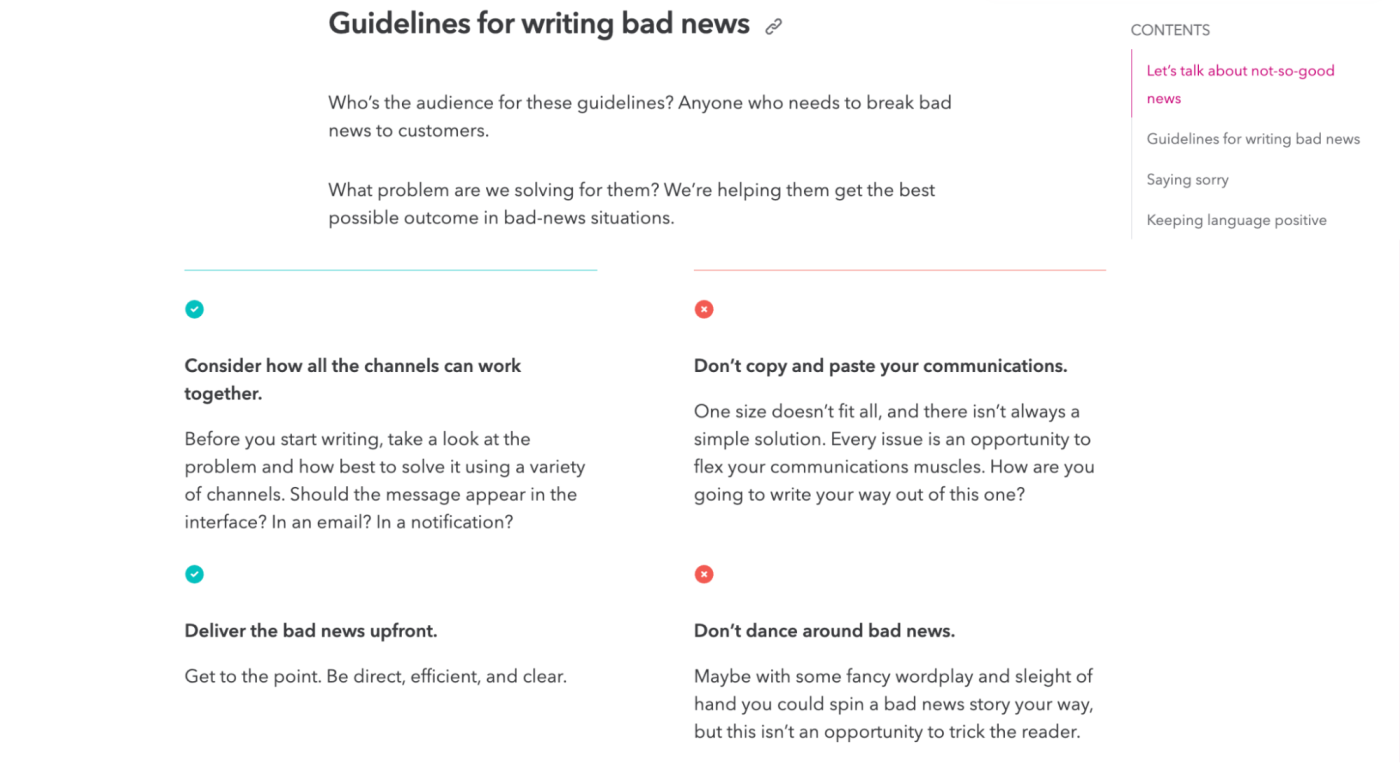
Do the same for your company if you have a large customer success team or sales department to have consistency in customer communication.
4. Grammar guidelines, word usage rules, and formatting information (essential)
Once you have the big elements nailed down, get into the tiny specifics. Make a skimmable section about your:
Grammar preferences (e.g., British English or American English)
Word usage rules (e.g., calling your buyers "customers" and not "users")
Formatting essentials (e.g., making bullet points longer or shorter as they stack)
Shopify's style guide has an exceptionally well-written grammar section with examples of dos and don'ts, so nothing is unclear.
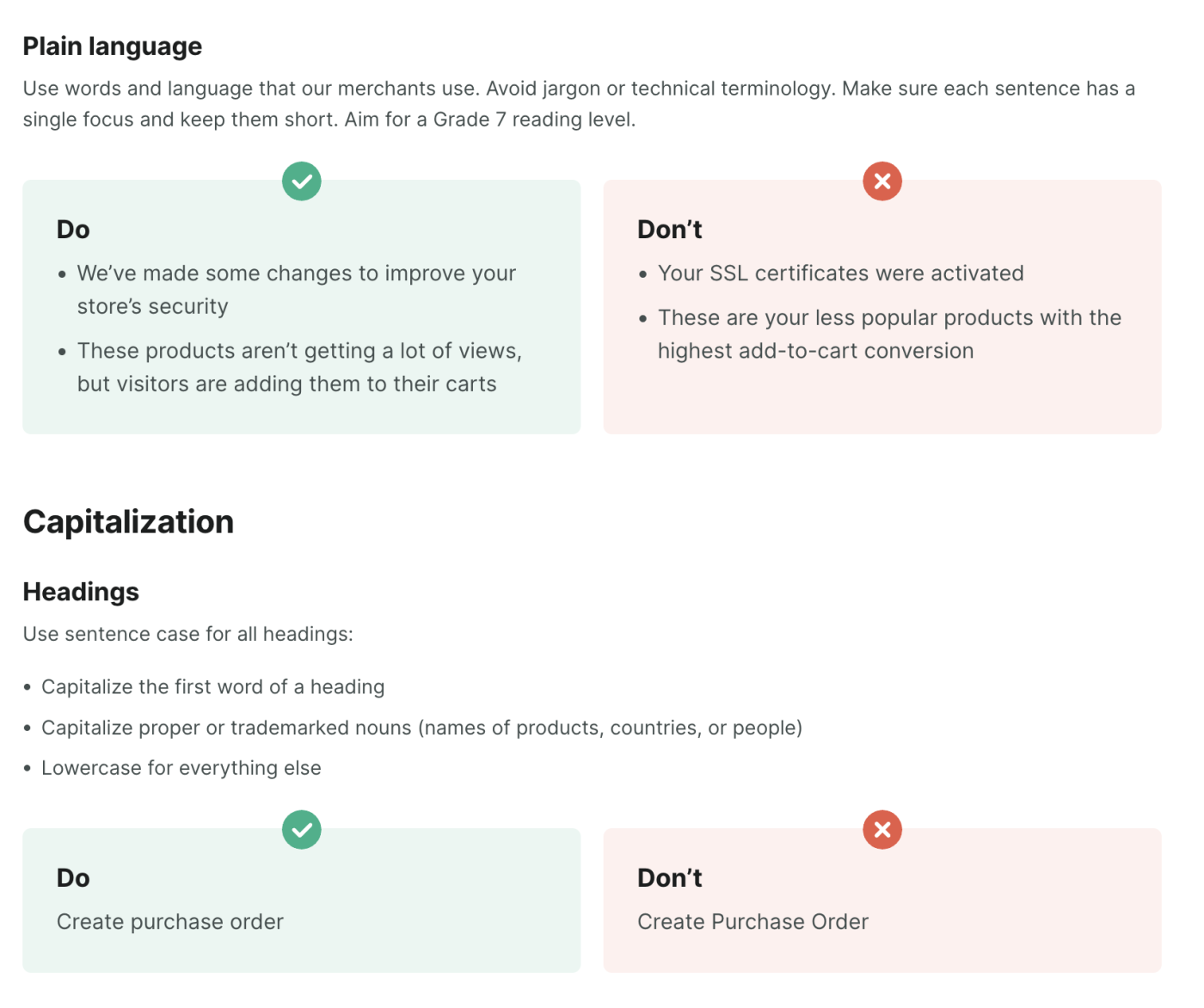
I'd recommend adding examples similar to Shopify because it makes the guidelines and preferences clear-cut. But I'd also add a skimmable checklist into your style guide for freelance writers, external contractors, and busy in-house employees to skim before publishing any piece they write for the company. AI tools like Writer and Grammarly are a big help here because they help enforce editorial rules without too much human intervention.
5. External and technical style guide (optional)
If you follow an external style guide—like AP Style Guide or Chicago Manual—link to the handbook in your internal style guide for easy reference. Summarizing the critical pointers for skimmability gets bonus points.
Technical writing instructions are also essential for tech brands. For instance, Google's developer style guide has extensive guidelines on how to write tech-heavy text.

6. Competitor information (optional)
Did your company do a thorough competitive market analysis? Summarize it in your style guide. This ensures:
External contractors don't reference them in your content.
Every worker understands what your company is doing best and where it can improve.
Employees and freelancers highlight how your products are different and/or better in their customer communication and content.
Competitor analysis doesn't need to be a long-winded ramble. Keep it short and snappy. If this information is sensitive and you don't want to reveal it to external contractors, write, "we differ from our competition through X." For example, Hulu highlights they do ads better and don't do advertising fraud in their style guide.
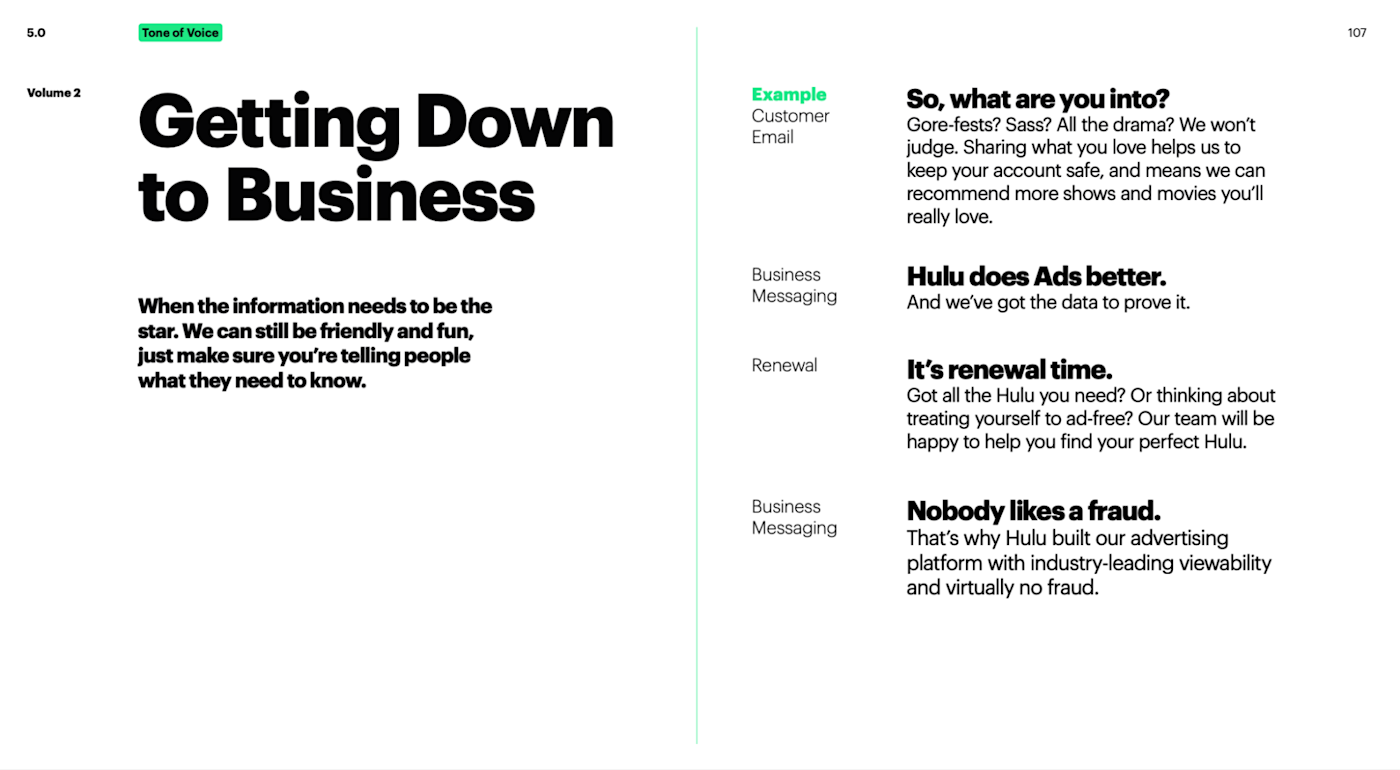
7. Channel-specific guidelines (optional)
Make different sections or variations for each channel. For example, New York University has a different style guide for social media with network-specific instructions.
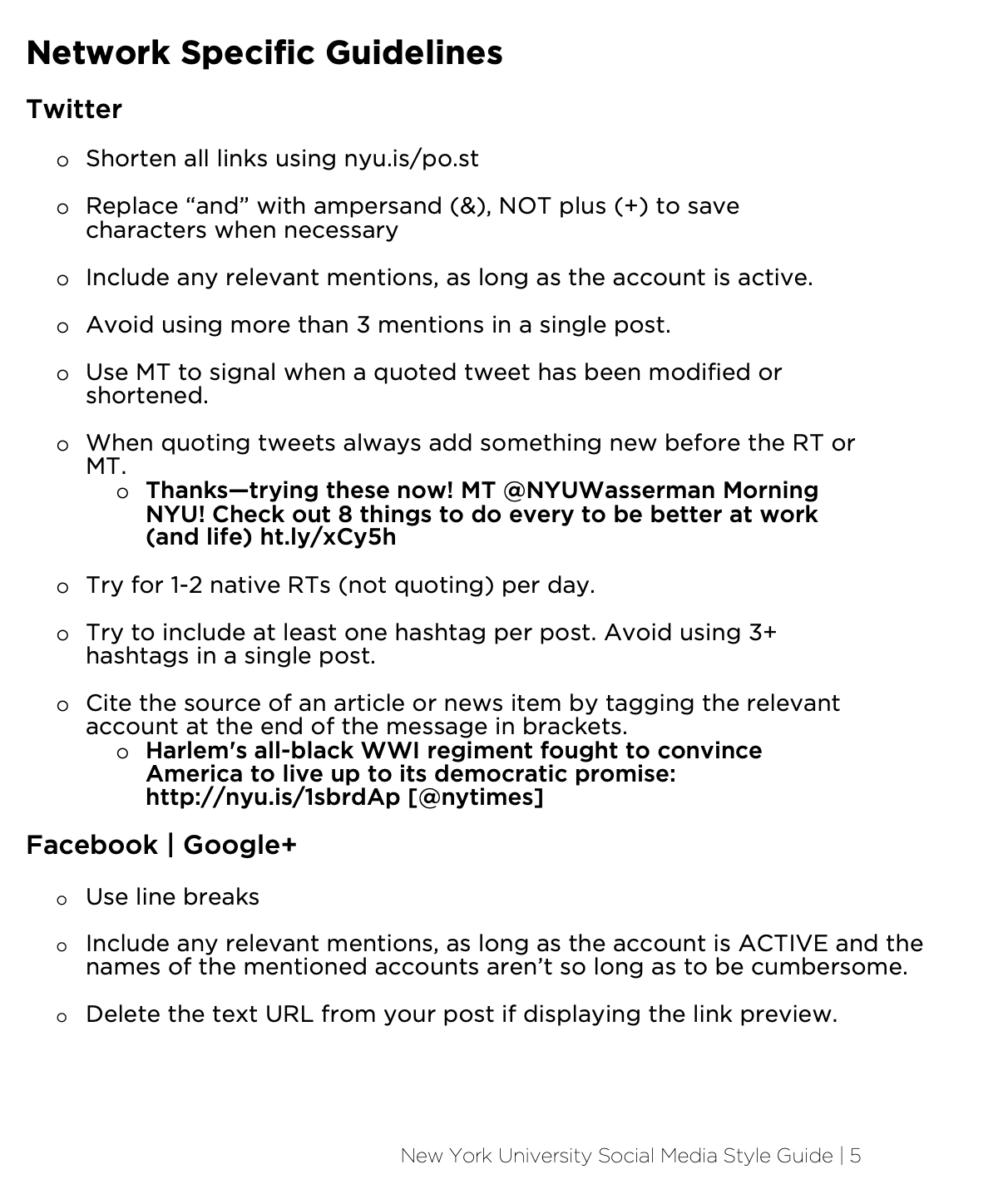
While you want to have the same brand identity, voice, and personality on all mediums and distribution channels, there are some areas where you might need different guidelines. The images that work on your blog might not work for social media because of formatting restrictions, for instance. The same goes for writing principles because of the character limit on social media.
8. Media, SEO, and hashtag guidelines (optional)
Visuals are a vital differentiator for any brand. Your design style guide would largely cover how your logo and typography appear, but you also need specific guidelines for images you share on social media or your blog.
Maybe you splash specific brand-color designs on your screenshots to make them identifiable.
Perhaps you have certain dimensions or size preferences.
Or maybe you want your visuals to be from a specific stock site.
Highlighting these media elements in your style guide will reduce your workload because all workers will ensure meeting the requirements in their self-editing process. Groove's style guide is a good example of having quick media guidelines, but feel free to explain more if you have specific preferences.
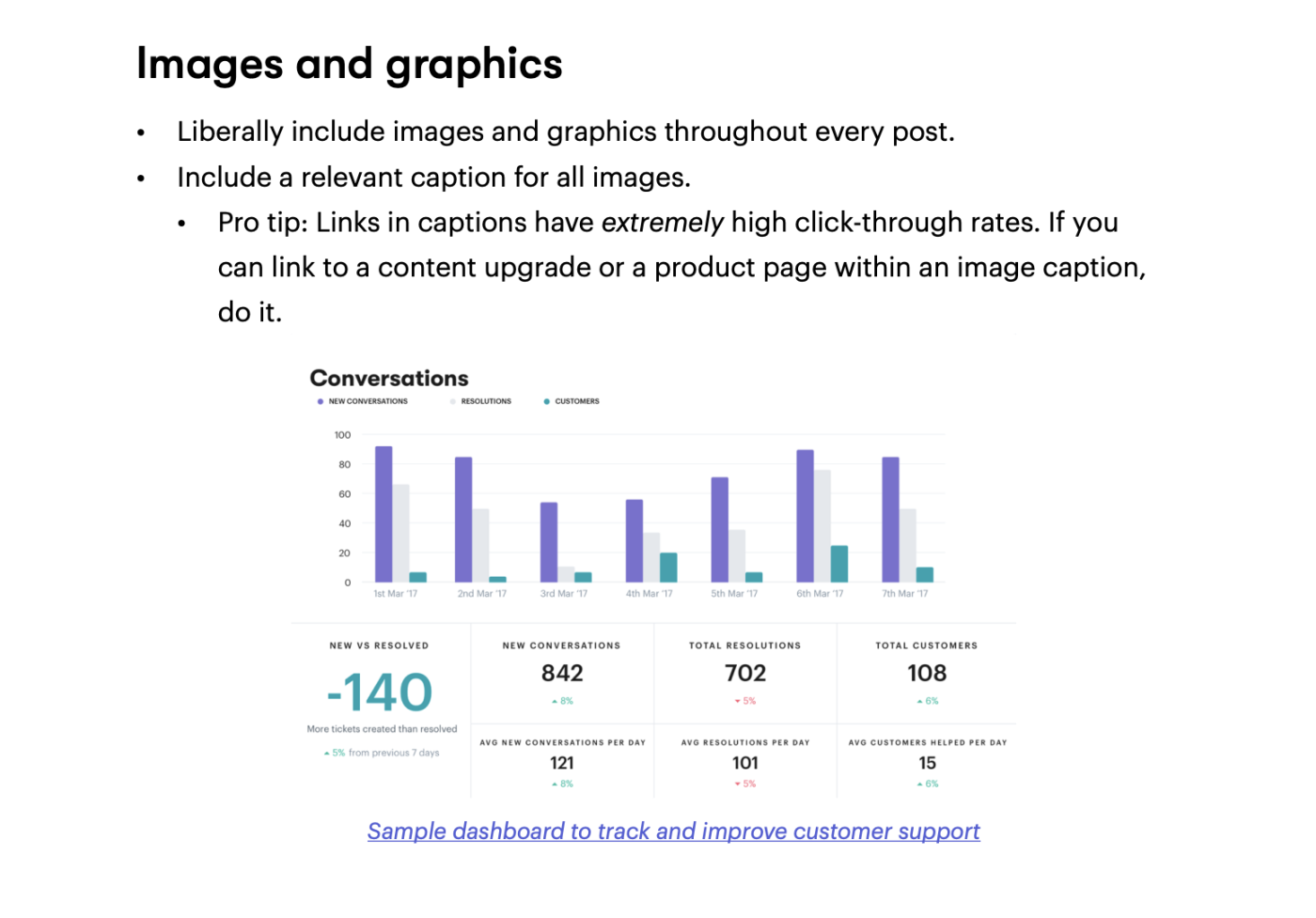
Like media guidelines, your style guide can also include SEO guidelines and hashtag guidelines. But these can only be overarching preferences—like don't use more than 11 hashtags—because any more would be specific to the context of the post. Search Engine Journal's guest posting guidelines do an excellent job of showcasing their preferred SEO best practices.

9. Best-performing content and examples of content you love (optional)
My onboarding checklist includes asking the client some examples of:
Their best-performing content
Content they love (from their own brand or another brand)
Knowing these two things help your in-house employees and freelance writers understand what works well for you in your content strategy and set a quality benchmark.
10. Resources to learn more about your company (optional)
Internal resources are far more valuable than they're ever given credit for. I proactively ask my clients in my content brief if they have any company resources I can look into. I've found a product course that helped me show off the best features, customer research data to help me speak the customer's language, and other precious insider info.
Sebastien Rankin, Senior Product Content Manager at Shopify and Founder of Rank Intent, says context about your company and services are essential components of a style guide:
"Give writers enough context into your products and services, and how they link to your content's categories. Things like grammar and style are table stakes in style guides, but teaching writers how to write about your product in relation to a topic speeds up the editing process for in-house teams and enables them to publish content faster without sacrificing subject matter expertise or quality."
You might be underestimating how many of your in-house employees are also unaware of some of the existing resources. Include them in your style guide as a quick list. They can be:
Competitor analysis
Product walkthrough
Company announcements
Customer research data and trends
Any company course you've created
A list of FAQs made by the customer success team
Recording of a sales call answering a customer's objections
Podcasts and interviews your company's founders/executives have done
…and anything else that deepens the knowledge of your company
How to help your company implement your style guide
There's nothing worse than spending time building a thorough style guide and having no one even glance at it before publishing something. So how do you increase the adoption of your style guide in your company?
I asked Aaron Orendorff, Head of Marketing at Recart, and his solution is to create Google Docs and Google Slides templates with your preferences embedded and outlined: "The only real success I've had is honestly creating, distributing, and constantly telling people to use one of two templates whenever they start any Google Doc or any Google Slide."
This way, whenever someone in the company wants to build something new, they'll use the template—which has your preferred fonts, style case, and other small things enabled by default.
Aaron preaches that the template method applies to increasing the implementation of every type of style guide, whether it's content or visual: "The key to consistently using a style guide is embedding it as usable and functional templates directly within the platforms people use to create."
In the template, have a TL;DR header for all your long sections that can't be embedded (like spelling preferences and grammar nuances). This makes it super easy to remember information and ensures nothing gets missed before publishing any piece. Mailchimp's style guide has an excellent one.

The style guide is a breathing document
The biggest mistake companies make is assuming style guides are a one-and-done deal. In reality, your style guide needs to be updated based on changes in your messaging, the product's UI, and branding transformations. For example, if you went through a huge rebrand, you likely need a few tweaks (if not more) in your style guide.
Mark it on your calendar to periodically revisit, revise, and revamp your style guide.
And when you update your style guide, write "this style guide was last updated on X date" to ensure no one misses the new changes. If possible, also highlight the modifications for quick skimming to save time. If you're using templates like Aaron suggested, update them directly so no one copies an older version.
Related reading:
Why a brand book is your business's key to building a strong brand
Choose your words carefully: How to build a brand lexicon for your marketing
This article was originally published in October 2018 by Laura McPherson. The most recent update was in April 2023.





